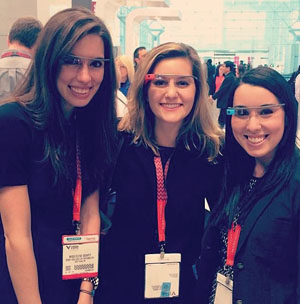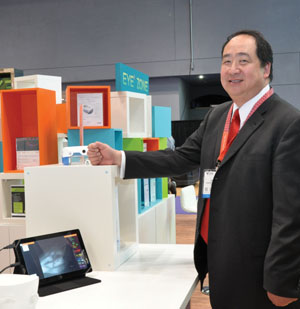 |
|
Many attendees got their first chance to test out Google Glass.
|
However, it was the future of contact lenses that proved to be an area of great interest.
Future of Contacts
This topic was addressed by Lyndon Jones, PhD, FCOptom, professor at the University of Waterloo, Ontario, Canada, and director of its Centre for Contact Lens Research. First, Dr. Jones underscored that the future of contact lenses includes managing myopia control. “The number of myopes will grow from 1.6 to 2.5 million by 2020,” he said.
But what can practitioners do to slow this looming epidemic? Undercorrecting myopes is not the answer, Dr. Jones said. The once-held theory of undercorrecting myopia to slow its progression has been proven to be ineffective; in fact, it may even accelerate it.1
Recently, CooperVision has developed a daily disposable lens called MiSight, currently available in Asia. The lens corrects myopia and eliminates aberrations on the peripheral retina that are thought to be one of the triggers of myopic progression, he explained.
“In addition to this product, many companies are currently testing various spectacle and contact lens designs in animal and human studies to investigate methods to slow the progression of myopia,” Dr. Jones said. “These include soft lens multifocal designs and also orthokeratology, with some studies showing up to 50% reduction in myopia progression.”2-4
Along with correcting vision and possibly slowing myopic progression, contact lenses that detect disease and monitor health are on the horizon. For example, Google’s Smart Contact Lens—which garnered a lot of press recently, although it’s still a prototype—would be used by diabetic patients to track the glucose content of their tears in order to better manage their disease.
 |
| David Yeh of Evena Medical demonstrates the Eyes-On Glasses at the Eye2 Zone. |
Healthy Eyes, Healthy Bodies
The notion that “healthy eyes are connected to healthy bodies” echoed throughout the CE courses at this year’s Vision Expo East.
In his lecture, “East Meets West: Effective Management of Ocular Conditions,” Aaron Lech, OD, of ClearVue Eye Care, in Roseville, Calif., explained how a personal experience that happened early in his career taught him a lot. He was working in an overseas clinic with an Indian ophthalmologist who saw 150 patients a day. Before even examining a particular patient’s eyes, the ophthalmologist told Dr. Lech that this patient probably had diabetic retinopathy.
“The patient had distended parotid glands, which are typically bilateral and asymptomatic in diabetics who are latent or physically asymptomatic (typically after 10 years),” Dr. Lech recalls.6 The ophthalmologist had noted the patient’s distended parotid glands and had reasoned that patients with longstanding, uncontrolled diabetes are more likely to have diabetic retinopathy. This experience taught Dr. Lech that observing and treating a patient as a whole can not only provide clues about the patient’s overall health, but about eye health as well.
He also discussed the ocular and systemic health benefits patients can gain by eating a healthy diet, exercising, reducing stress and avoiding smoking, and he spoke about how proper nutrition and supplements can influence common ocular conditions such as AMD, cataracts, dry eye syndrome, lid disease and glaucoma.7-12
 |
|
Charles Posternack, MD, gave the keynote address on health care reform.
|
High-Tech Eye Tech
The latest in wearable technologies were on display at Vision Monday’s Eye2 Zone.
Google Glass demonstrations were a big draw, but the Eye2 Zone also featured technological advances that can help eye care providers deliver better care, such as Eyes-On Glasses (Evena Medical). No more guessing which is the best vein to draw blood from—these glasses allow health care professionals to “see right through the skin” and easily image the vasculature beneath it, which can optimize care and minimize discomfort to patients.
Low vision specialists were introduced to OrCam, a frame-mounted device that uses advanced computer vision to “read” text and recognize objects, and then voices that information via an earpiece. Its goal is to help the visually impaired and blind regain functionalities and independence.
1. Adler D, Millodot M. The possible effect of undercorrection on myopic progression in children. Clin Exp Optom. 2006 Sep;89(5):315-21.
2. Smith EL, 3rd, Campbell MC, Irving E. Does peripheral retinal input explain the promising myopia control effects of corneal reshaping therapy (CRT or ortho-K) & multifocal soft contact lenses? Ophthalmic Physiol Opt. 2013 May;33(3):379-84.
3. Sivak J. The cause(s) of myopia and the efforts that have been made to prevent it. Clin Exp Optom. 2012 Nov;95(6):572-82.
4. Walline JJ, Lindsley K, Vedula SS, et al. Interventions to slow progression of myopia in children. Cochrane Database Syst Rev. 2011 Dec 7;(12):CD004916.
5. Von Thun Und Hohenstein-Blaul N, Funke S, Grus FH. Tears as a source of biomarkers for ocular and systemic diseases. Exp Eye Res. 2013 Dec;117:126-37.
6. Russotto SB. Asymptomatic parotid gland enlargement in diabetes mellitus. Oral Surg Oral Med Oral Pathol. 1981 Dec;52(6):594-8.
7. Age-Related Eye Disease Study 2 Research Group. Lutein + zeaxanthin and omega-3 fatty acids for age-related macular degeneration: the Age-Related Eye Disease Study 2 (AREDS2) randomized clinical trial. JAMA. 2013 May 15;309(19):2005-15.
8. Chew EY. Nutrition effects on ocular diseases in the aging eye. Invest Ophthalmol Vis Sci. 2013 Dec 13;54(14):ORSF42-7.
9. Rand AL, Asbell PA. Nutritional supplements for dry eye syndrome. Curr Opin Ophthalmol. 2011 Jul;22(4):279-82.
10. Oleñik A, Jiménez-Alfaro I, Alejandre-Alba N, Mahillo-Fernández I. A randomized, double-masked study to evaluate the effect of omega-3 fatty acids supplementation in meibomian gland dysfunction. Clin Interv Aging. 2013;8:1133-8.
11. Renard JP, Rouland JF, Bron A, et al. Lifestyle and environmental factors in ocular hypertension and primary open-angle glaucoma: an exploratory case-control study. Acta Ophthalmol. 2013 Sep;91(6):505-13.
12. Pasquale LR, Kang JH. Lifestyle, nutrition, and glaucoma. J Glaucoma. 2009 Aug;18(6):423-8.

